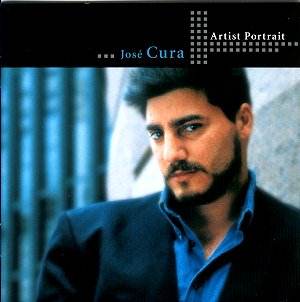Born on December 5th 1962 in Rosario, Argentina,
Cura first studied composition and conducting before taking any
vocal studies and trying for a career as a singer. He began to make
it big after winning the Placido Domingo ‘International Operalia Prize’
in 1994. Given the dearth of tenors, his big heroic voice seemed like
a gift from heaven to opera house intendants and his star rose rapidly
as a putative future 4th tenor. Signed by Warner, his first
disc, ’Puccini Arias’ conducted by Domingo, appeared in 1997 to generally
favourable reviews. Cura subsequently appeared as Alfredo in the film
‘La Traviata a Paris’ and in complete recordings of Saint-Saëns’
Samson and Delila (1998) and in a Decca recording of Pagliacci.
Two further developments were to be significant influences
in Cura’s stage performances and recording career. First, at the young
age of 34, he sang his first Otello; second, in his two subsequent opera
recital discs for Warner he conducted his own singing (‘Verdi Arias’
and ‘Verismo’). A good conductor will not only allow the singer
to phrase and characterise but also be faithful to the composer and
guide the singer as to interpretation etc. On this disc the difference
between Domingo conducting Cura in Puccini (tr 1, 12, 13, 15 and 19)
and the singer conducting himself in Verdi (tr 2, 3, 9 and10) is simply
self indulgence with both singer and composer suffering. The same failings
are evident in the tracks taken from the ‘Verismo’ album (tr
5-8, 11and 14).
As to the singing, Cura’s big baritonal sound, and
particularly style, is more in the tradition of say Del Monaco or Bonisolli
than Bergonzi or Pavarotti. A big voice can be too large for Alfredo
(Traviata) or Rodolpho (La Boheme, tr 12 and 13) unless the singer has
Domingo’s skill in lightening the vocal tone and weight. Cura doesn’t
have that skill, so that Mimi would be bullied rather than seduced into
love; his phrasing is lumpy and lacking grace with the voice sounding
dry in the middle. In the Turandot and Verismo extracts
the singing can be viscerally exciting as long as the listener is looking
to thrills not sensitivity.
Whatever the reason, whilst Cura’s big sound taken
him to the major opera houses in the heroic tenor roles, his Warner
contract, like many others, has hit the skip. As far as this ‘Artist
Portrait’ is concerned, it is a good representation of his voice and
interpretative skills in the heroic tenor repertoire, which seems to
be where his instrument and preference lie. The inadequate brief booklet
gives no recording dates or even total time, although the latter can
just be gleaned at the bottom right hand corner of the back details.
The sparse somewhat eulogistic biographical details are given in English,
German and French.
Robert J Farr
